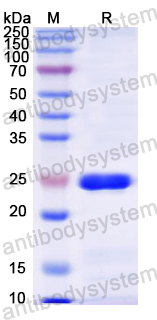Catalog No.
YMN44701
Expression system
E. coli
Species
Mus musculus (Mouse)
Protein length
Arg26-Lys218
Predicted molecular weight
24.84 kDa
Nature
Recombinant
Endotoxin level
Please contact with the lab for this information.
Purity
>90% as determined by SDS-PAGE.
Accession
O35622
Applications
ELISA, Immunogen, SDS-PAGE, WB, Bioactivity testing in progress
Form
Lyophilized
Storage buffer
Lyophilized from a solution in PBS pH 7.4, 0.02% NLS, 1mM EDTA, 4% Trehalose, 1% Mannitol.
Reconstitution
Reconstitute in sterile water for a stock solution. A copy of datasheet will be provided with the products, please refer to it for details.
Shipping
In general, proteins are provided as lyophilized powder/frozen liquid. They are shipped out with dry ice/blue ice unless customers require otherwise.
Stability and Storage
Use a manual defrost freezer and avoid repeated freeze thaw cycles. Store at 2 to 8°C for frequent use. Store at -20 to -80°C for twelve months from the date of receipt.
Alternative Names
Fibroblast growth factor 15, FGF-15, Fgf15
Lactobacillus rhamnosus GG maintains gut microbiota stability and promotes intestinal adaptation via activated intestinal farnesoid X receptor signaling in short bowel syndrome., PMID:40425822
ZeXieYin formula alleviates atherosclerosis by regulating SBAs levels through the FXR/FGF15 pathway and restoring intestinal barrier integrity., PMID:40414923
Inhibition of Farnesoid-x-receptor signaling during abdominal sepsis by dysbiosis exacerbates gut barrier dysfunction., PMID:40399878
Platycodonis radix polysaccharides suppress progression of high-fat-induced obesity through modulation of intestinal microbiota and metabolites., PMID:40354675
Hepatic and intestinal tissue-specific Fxr deficiency alters bile acid homeostasis in female mice., PMID:40338063
Salvianolic acid B attenuates hypercholesterolemia via modulating the gut microbiota and bile acid metabolism., PMID:40334726
Epiberberine ameliorates ulcerative colitis by regulating bile acids hepatoenteral circulation through intestinal FXR., PMID:40334429
The role of gut microbiota on skeletal muscle strength in LDLR knockdown aging mice., PMID:40312444
Suppressed intestinal secondary bile acids in moxifloxacin-induced hyperglycemia: studies in normal and diabetic GK rats., PMID:40255568
Gut Microbiota and Its Metabolite Taurine-β-Muricholic Acid Contribute to Antimony- and/or Copper-Induced Liver Inflammation., PMID:40244173
Lactococcus petauri LZys1 modulates gut microbiota, diminishes ileal FXR-FGF15 signaling, and regulates hepatic function., PMID:40243350
Schisandra chinensis lignans ameliorate hepatic inflammation and steatosis in methionine choline-deficient diet-fed mice by modulating the gut-liver axis., PMID:40222688
Nobiletin Enhances Skeletal Muscle Mass and Modulates Bile Acid Composition in Diet-Induced Obese Mice., PMID:40193085
Farnesoid X Receptor Regulated Sepsis-Induced Abnormal Bile Acid Metabolism via the Fibroblast Growth Factor 15/Fibroblast Growth Factor Receptor 4 Pathway., PMID:40192065
Short-chain fatty acids alleviate cholestatic liver injury by improving gut microbiota and bile acid metabolism., PMID:40186906
Alterations in intestinal bile acid transport provide a therapeutic target in patients with post-bariatric hypoglycaemia., PMID:40186075
Triterpenoids from ilicis rotundae cortex ameliorate hyperlipidemia by affecting bile acids-hepatointestinal FXR axis., PMID:40023069
Oat β-glucan prevents high fat diet induced obesity by targeting ileal Farnesoid X receptor-fibroblast growth factor 15 signaling., PMID:40020836
Alpha-aminobutyric acid ameliorates diet-induced metabolic dysfunction-associated steatotic liver disease (MASLD) progression in mice via enhancing AMPK/SIRT1 pathway and modulating the gut-liver axis., PMID:40015656
Activation of gut FXR improves the metabolism of bile acids, intestinal barrier, and microbiota under cholestatic condition caused by GCDCA in mice., PMID:39982108
Sanye tablet regulates gut microbiota and bile acid metabolism to attenuate hepatic steatosis., PMID:39971018
High-fat diet promotes gestational diabetes mellitus through modulating gut microbiota and bile acid metabolism., PMID:39935515
Galactooligosaccharide-Metabolism-Related Genes of Bifidobacterium pseudocatenulatum Contribute to the Regulation of Glucose and Lipid Metabolism in Type 2 Diabetic Mice., PMID:39801054
Deficiency of Epithelial PIEZO1 Alleviates Liver Steatosis Induced by High-Fat Diet in Mice., PMID:39781454
Ramulus Mori (Sangzhi) alkaloids ameliorate high-fat diet induced obesity in rats by modulating gut microbiota and bile acid metabolism., PMID:39758340
FGF19-Activated Hepatic Stellate Cells Release ANGPTL4 that Promotes Colorectal Cancer Liver Metastasis., PMID:39716892
Clostridium Scindens Protects Against Vancomycin-Induced Cholestasis and Liver Fibrosis by Activating Intestinal FXR-FGF15/19 Signaling., PMID:39680750
High-fat/high-sucrose diet results in a high rate of MASH with HCC in a mouse model of human-like bile acid composition., PMID:39670881
Ginsenosides From Panax ginseng Improves Hepatic Lipid Metabolism Disorders in HFD-Fed Rats by Regulating Gut Microbiota and Cholesterol Metabolism Signaling Pathways., PMID:39660634
Integrating network pharmacology and animal experimental validation to investigate the mechanism of lotus leaf in obesity., PMID:39647284
Liver-gut axis signaling regulates circadian energy metabolism in shift workers., PMID:39588921
Overexpression of TNFα in TNF∆ARE+/- mice increases hepatic periportal inflammation and alters bile acid signaling in mice., PMID:39585296
The role of FGF15/FGF19 in the development of the central nervous system, eyes and inner ears in vertebrates., PMID:39579736
Identification of chikusetsusaponin IVa as a novel lysine-specific demethylase 1 inhibitor that ameliorates high fat diet-induced MASLD in mice., PMID:39567752
A primer on the pleiotropic endocrine fibroblast growth factor FGF19/FGF15., PMID:39500656
Low polarity fraction of Radix Bupleuri alleviates chronic unpredictable mild stress-induced depression in rats through FXR modulating bile acid homeostasis in liver, gut, and brain., PMID:39489929
Abnormal enterohepatic circulation of bile acids caused by fructooligosaccharide supplementation along with a high-fat diet., PMID:39450588
The total alkaloids of Berberidis Cortex alleviate type 2 diabetes mellitus by regulating gut microbiota, inflammation and liver gluconeogenesis., PMID:39426578
Hepatic FXR-FGF4 is required for bile acid homeostasis via an FGFR4-LRH-1 signal node under cholestatic stress., PMID:39393353
Parenteral nutrition results in peripheral ileal to hepatic circadian discordance in mice., PMID:39301965
Characterization of FGF21 Sites of Production and Signaling in Mice., PMID:39253796
Lactobacillus acidophilus ameliorates cholestatic liver injury through inhibiting bile acid synthesis and promoting bile acid excretion., PMID:39205654
Yellow tea polysaccharides protect against non-alcoholic fatty liver disease via regulation of gut microbiota and bile acid metabolism in mice., PMID:39153277
Gut-muscle communication links FGF19 levels to the loss of lean muscle mass following rapid weight loss., PMID:39134173
Perfluorooctanoic acid (PFOA) and its alternative perfluorobutanoic acid (PFBA) alter hepatic bile acid profiles via different pathways., PMID:39122034
Fluoride induces hepatointestinal damage and vitamin B2 mitigation by regulating IL-17A and Bifidobacterium in ileum., PMID:39097090
Endocrine fibroblast growth factors in domestic animals., PMID:39059301
Nuclear factor interleukin 3 and metabolic dysfunction-associated fatty liver disease development., PMID:39048678
Bile Acid Injection Regulated Blood Glucose in T2DM Rats Via the TGR5/GLP-1 Rather than FXR/FGF15 Pathway., PMID:39038352
Pulsatilla decoction alleviates DSS-induced UC by activating FXR-ASBT pathways to ameliorate disordered bile acids homeostasis., PMID:38974033

